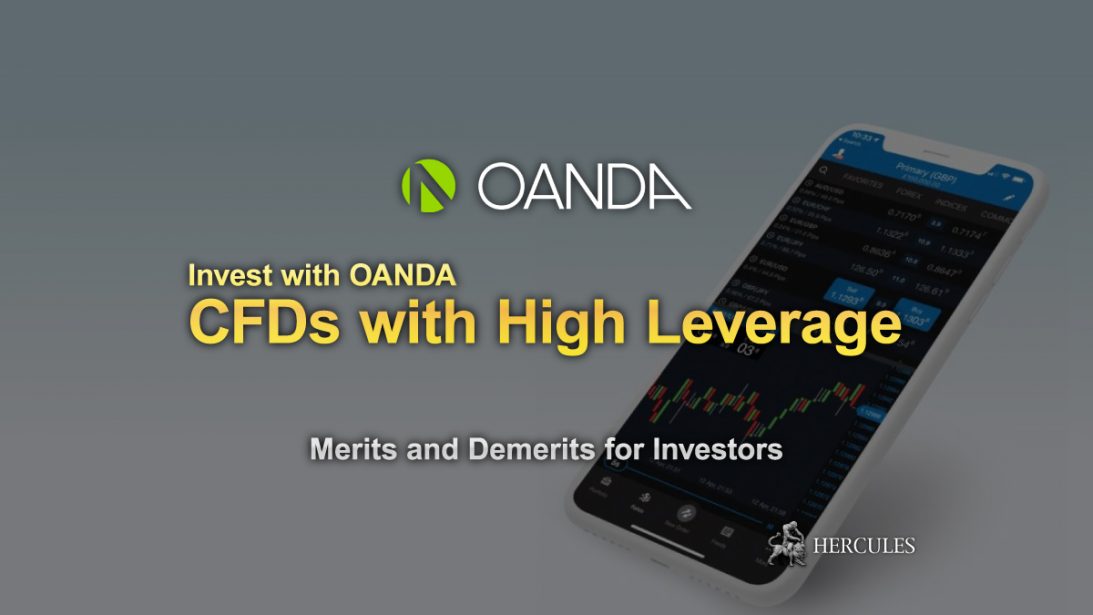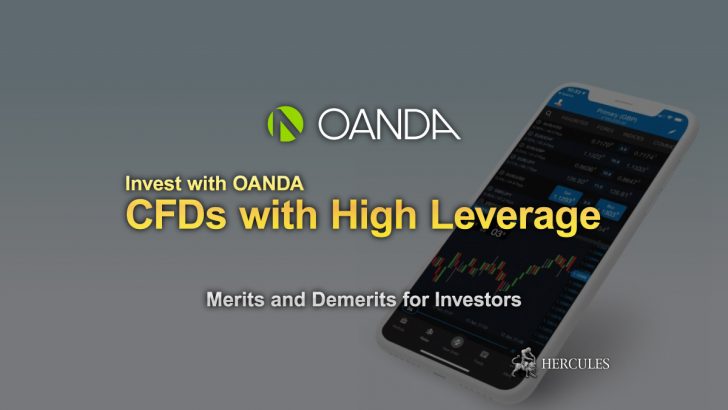Categories
Types of CFDs and Merits & Demerits for Investors


Notice
This Post has ended its release period. Please check OANDA's latest information and campaign on OANDA's company introduction page.
OANDA - What's now?
We are no longer promoting OANDA. The information regarding to OANDA on the website '' maybe outdated. ref. OANDA
What is CFD (Contract for Difference)?
CFD (Contract for Difference) is an abbreviation for “Contract for Difference”.
We trade products such as stock indexes, crude oil, and gold, but you can buy and sell without actually owning the actual product.
FX (Foreign Exchange Margin Trading), which is very popular with traders, is also one of the CFD (Contract for Difference) investments.
A contract for difference transaction is a transaction in which the object of the transaction is not delivered, but only the profit or loss generated by the transaction is delivered on the premise that the transaction is settled.
CFD trading is carried out by depositing the margin specified for each issue and delivering the profit and loss by adjusting the amount of the margin.
Go to OANDA’s Official Website
Invest in Stock Index CFDs
Stock index CFD is to quantify the stock price of a certain stock and uses it as the price of the underlying asset for trading.
A characteristic of the market is that prices tend to rise when the economy improves, and fall when the economy deteriorates.
It also introduces the difference between futures trading and CFD trading with Nikkei 225 as the underlying asset.
CFD trading has the advantage that you can start with a small amount and the trading time is long.
CFDs can be used not only for trading to change the price of a stock index but also for hedging cash and futures trading.
Popular stock index CFDs are:
- Nikkei 225
- It is a stock index that represents Japan and consists of 225 representative stocks listed on the First Section of the Tokyo Stock Exchange. It is one of the important indicators that reflect the trends of the Japanese economy, and you can judge the trends from news and newspapers.
- NY Dow
- It is made up of 30 leading companies in major industries that represent the United States. Since most are multinational corporations, it reflects the global economy and is susceptible to foreign exchange.
- FTSE100
- It is made up of the top 100 stocks listed on the London Stock Exchange by market capitalization. It is characterized by a large number of financial-related (especially banking and insurance) and resource-related stocks.
- DAX
- It is made up of 30 excellent German companies listed on the Frankfurt Stock Exchange. Since Germany is an industrialized country, it has a high proportion of chemicals and industry and is highly dependent on exports.
Type of CFD Products
When trading, it is necessary to include a surplus margin in addition to the required margin amount in case the market moves in the opposite direction in the short term.
This surplus margin will be able to withstand unrealized losses.
1. Exchange CFD (Contract for Difference)
Exchange CFD (Contract for Difference) trades using “Click Stock 365” provided by the Tokyo Financial Exchange.
In the unlikely event that a trader goes bankrupt, you can trade with confidence because the margin deposited by the investor is fully guaranteed.
However, the number of trading stocks is smaller than that of over-the-counter CFD (Contract for Difference).
Invest in Exchange CFDs on OANDA
2. Over-the-counter CFD (Contract for Difference)
Over-the-counter CFDs (Contract for Differences) deal directly with companies that offer CFDs (Contract for Differences) without going through an exchange.
Since OANDA uses bilateral transactions, the company that offers CFD (Contract for Difference) offers the price.
OANDA offers over-the-counter CFDs (Contract for Difference).
In addition, compared to exchange CFD (Contract for Difference), it has features such as a large number of stocks and low transaction costs.
What are the merits of trading CFDs?
There are various merits to trade CFDs on OANDA and here are some main ones.
1. You can trade almost 24 hours in the global market
CFD (Contract for Difference) can be traded almost 24 hours a day, depending on the brand.
The popular Nikkei Stock Average (JP225) and Nasdaq 100 Index (NASDAQ) can be traded almost 24 hours a day.
Even office workers who are busy with work and housewives who are busy with housework and childcare can make transactions according to their lifestyle with CFD (Contract for Difference).
2. Leveraged trading allows you to invest efficiently with a small amount of money
CFD (Contract for Difference) can start trading from a small amount, depending on the brand.
For example, with OANDA’s Nikkei Stock Average (JP225), you can start trading from one unit, so you can start trading from about 280 dollars (as of January 4, 2021).
In addition, you can leverage up to 10 times more leverage, so you can start trading from as little as 28 dollars(as of January 4, 2021).
Since CFD (Contract for Difference) can utilize leverage, it is possible to make large transactions with a small amount of funds.
3. You can trade from both sell and buy
CFDs (Contract for Difference) can be profitable from both sells and buys.
If the market is on an uptrend, you can buy it, and if the market is on a downtrend, you can sell it to increase your chances of making a profit.
In addition, being able to target both selling and buying can also be used as a risk hedge.
For example, when the entire stock involved in the portfolio is on the decline, it is possible to offset profits and losses by temporarily counter-trading.
Being able to make a profit from both selling and buying can be used not only as a profit opportunity but also as a risk hedge.
Go to OANDA’s Official Website
What are the demerits of trading CFDs?
While there are many merits to trade CFDs on OANDA, there are also some demerits that you need to know.
1. Trading with high leverage is risky
CFD (Contract for Difference) has a big advantage in that it can utilize leverage, but if you use it incorrectly, you risk a big loss.
Even if you use high leverage, only the risk will be high, so it is necessary to set the leverage according to trading skills and margin.
2. There is a big risk of loss
Stop-loss rules apply to CFDs (Contract for Difference).
If it falls below the required margin rate, a loss cut will be activated and counter-trading will be forcibly carried out, and the open interest (holding position) will be settled and the loss will be confirmed.
To prevent this, you need to deposit an additional margin.
In addition, in the case of sudden market fluctuations, the price at the time of loss cut judgment may not be executed, but the contract may be executed at a more unfavorable price, resulting in a loss exceeding the deposited margin and a large loss.
3. You need to create a dedicated account for CFD (Contract for Difference)
To make a CFD (Contract for Difference), you need to open an account dedicated to CFD (Contract for Difference).
If you already have an OANDA FX account, you can easily open a CFD account from My Page.
Differences between CFDs and Forex
First of all, the difference between CFD and FX (Foreign Exchange Margin Trading) lies in the trading stock.
CFDs trade stock indexes, commodities, etc., while FX trade currencies. (*OANDA can only trade stock index CFDs. Commodities CFDs cannot be traded yet.)
Next, the difference between CFDs and futures trading is that the trading method is different.
In principle, CFDs can be settled whenever the market is open.
However, futures contracts are traded by specifying a settlement date and price. Since you have to settle under predetermined conditions, you cannot settle freely at a reasonable price like CFD.
For CFD trading of OANDA’s stock index, 10% of the transaction amount is set as the minimum required margin.
If you want to trade 10,000 dollars, you need a margin of 1,000 dollars.
For example, the minimum trading unit in OANDA’s Nikkei Stock Index 225 (JP225) is one unit.
If the asking price is 200 dollars, the required margin will be 20 dollars.
OANDA has a demo account for CFD trading. A demo account is a pseudo-transaction using virtual currency.
If you are reluctant to spend money suddenly, you can start with a demo transaction because you can experience the profit and loss of funds in a real way.
With OANDA, you can choose from MT4, MT5 and TradingView platforms.












